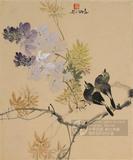宋高宗后坐像 軸
推薦分享
資源連結
連結到原始資料 (您即將開啟新視窗離開本站)後設資料
- 資料識別:
- 中畫000279N000000000
- 資料類型:
- 類型:繪畫
- 型式:靜態圖像
- 主題與關鍵字:
- 后妃 傢俱(屏風)
- 出版者:
- 數位化執行單位:國立故宮博物院
- 格式:
- 本幅 189.4x104公分、全幅 138.4公分
- 關聯:
- 故宮書畫錄(卷七),第四冊,頁28-29&*1.王耀庭,〈宋高宗皇后坐像〉,收入王耀庭主編,《傳移模寫》(臺北:國立故宮博物院,2007年初版),頁30。 2.劉芳如,〈宋高宗后坐像〉,收入何傳馨主編,《文藝紹興:南宋藝術與文化•書畫卷》(臺北:國立故宮博物院,2010年十月初版一刷),頁336。&*高宗先後立過兩后,元配邢夫人於靖康之難時被俘,高宗即位後,遙冊其為皇后。紹興十二年(1142),邢后棺槨由北地迎回,吳夫人才正式被冊立為后。吳后夙喜讀書,翰墨的修養高絕,曾經為高宗代筆,人莫能辨,故深受高宗寵信。本像所繪,應為續立的吳后。畫中人物,頭戴九龍花釵冠,面貼珠鈿。身著深青色禕衣,上繡對雉十二行,並用朱色作邊飾,上再綴以龍紋,鮮豔、華美至極。(20101015)&* Gaozong had two empresses, one before and one after he became the first Southern Song emperor. His first wife, Lady Xing, was captured when the Northern Song capital was invaded by the Jin during the Jingkang Disaster of 1126. After Gaozong became emperor, she was elevated in absentia to the status of empress. In 1142, the coffin of Empress Xing was returned to the Song, and Lady Wu (?-1197) thereupon formally became Gaozong's empress. Wu was fond of study and became highly skilled in calligraphy. Writing for the emperor on his behalf, she proved to be very capable, earning his deep trust and fondness. This portrait was probably painted after she became empress. In the painting, Empress Wu wears a nine-dragon hairpin floral crown with pearl decor pasted onto her face. She has a dark blue robe embroidered with twelve pairs of pheasants and featuring red decorative bordering, onto which is stitched dragon patterns to create an extremely colorful and beautiful appearance.(20101015)
- 管理權:
- 國立故宮博物院
授權聯絡窗口
- 國立故宮博物院圖像授權、出版授權、影音資料授權-申請流程說明
http://www.npm.gov.tw/zh-TW/Article.aspx?sNo=03003061






